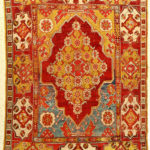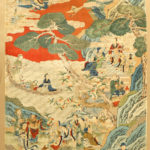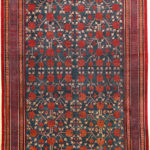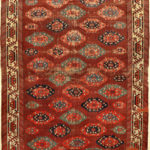Collector Carpets at Henry’s, Mutterstadt, 8 December 2018

Sale preview
10 images
Lots from Henry’s 'Collector Carpets' sale, including a selection of rare Tibetan rugs, Chinese, Persian and Anatolian 'Transylvanian' rugs, as well as Caucasian carpets and early Turkmen rugs.
- Lot 7133, Imperial Chinese silk and gold metal-thread Ningxia Dragon ‘Temple-Carpet’, Qing Dynasty, West China, 19th century. 2.80 x 1.88 m. Henry’s Auktionshaus, 8 December 2018, estimate €21-35,000
- Lot 7215, Lotto Ushak rug, West Anatolia, 17th century, 1.71 x 1.21 m. Henry’s Auktionshaus, 8 December 2018, estimate €8,200-16,000
- Lot 7314, Bakshaish Carpet, Northwest Persia, Henry’s Auktionshaus, 8 December 2018, estimate €14,000-16,000
- Lot 7135, Imperial Chinese silk and gold metal-thread yellow Turfan Dragon ‘Palace Rug’, Qing Dynasty, West China, 19th century. 2.50 x 1.55 m. Henry’s Auktionshaus, 8 December 2018, estimate €8,500-22,000
- Lot 7207, Early Transylvanian double-niche Ushak rug, West Anatolia, 18th century. 1.72 x 1.20 m. Henry’s Auktionshaus, 8 December 2018, estimate €4,200-8,500
- Lot 7310, Heriz Serapi carpet, Northwest Persia, 19th century. 4.30 x 2.80 m. Henry’s Auktionshaus, 8 December 2018, estimate €16,000-25,000
- Lot 7124, Early Imperial fine silk and metal-thread Kesi tapestry, Northeast China, 17th/18th-century. 1.90 x 0.95 m. Henry’s Auktionshaus, 8 December 2018, estimate €2,200-7,500
- Lot 7136, Silk Yarkand carpet (Pomegranate-Vase Design), East Turkestan, early 19th century. 3.34 x 1.70 m. Henry’s Auktionshaus, 8 December 2018, estimate €7,200-11,000
- Lot 7217, Multi-Medallion Ushak Carpet, West Anatolia, circa 1700. 4.96 x 2.72 m. Henry’s Auktionshaus, 8 December 2018, estimate €8,200-14,000
- Lot 7260, Yomut C-Gul Main Carpet, Turkmenistan, first half 19th century. 2.87 x 1.60 m. Henry’s Auktionshaus, 8 December 2018, estimate €1,600-6,500
Henry’s Auktionshaus will be offering a selection of 416 lots at their special winter auction, ‘Collector Carpets’ on 8 December 2018. The sale features a fine selection of rare Tibetan rugs from a private German collection and decorative carpets from a private Australian collection. Highlights include a spectacular collection of Chinese rugs, a small selection of imperial silk and metal-thread rugs and Persian town rugs from famous master workshops. Furthermore, exemplary Anatolian ‘Transylvanian’ rugs, and many collectible Caucasian carpets and early Turkmen rugs from private collections will be auctioned.

Lot 7133, Imperial Chinese silk and gold metal-thread Ningxia Dragon ‘Temple-Carpet’ (detail), Qing Dynasty, West China, 19th century. 2.80 x 1.88 m. Henry’s Auktionshaus, 8 December 2018, estimate €21-35,000
Among the Chinese rugs is a signed silk and gold metal-thread Ningxia dragon temple-carpet (lot 7133). Five clawed dragons hunt a flaming-pearl against a gold-metal brocaded ground within a multicoloured water-wave border. The cartouche inscription indicates the piece was made for imperial use in the temple of heaven (one of the most important temples in Beijing located near the forbidden city in the former district of Chongwen), making it one of only a few extant known textiles affiliated with this temple.

Lot 7124, Early Imperial fine silk and metal-thread Kesi tapestry (detail), Northeast China, 17th/18th-century. 1.90 x 0.95 m. Henry’s Auktionshaus, 8 December 2018, estimate €2,200-7,500
Henry’s small selection of imperial silk and metal-thread rugs boasts an early imperial silk and metal-thread Kesi tapestry, dated to the late 17th-18th century, ‘probably made for the forbidden city in Beijing’ (lot 7124). The Chinese ‘peach-festival’ is depicted, a popular Daoist theme associated with the birthday celebration of Xiwangmu. The faces of the people have been painted by a master, each with individual expressions.

Lot 7135, Imperial Chinese silk and gold metal-thread yellow Turfan Dragon ‘Palace Rug’ (detail), Qing Dynasty, West China, 19th century. 2.50 x 1.55 m. Henry’s Auktionshaus, 8 December 2018, estimate €8,500-22,000
Lot 7135 is a rare 19th century Imperial Chinese silk and gold metal-thread yellow Turfan Dragon palace rug (Qing Dynasty), ‘made for the imperial palaces in the forbidden city Beijing’. The design reveals five-clawed dragons on an imperial yellow ground, hunting the pearl, made for the palaces in the forbidden city Beijing. The imperial dynasties had strict regulations on the use of colour, the colour yellow became imperial and only the Emperor of China could wear yellow clothes or own yellow utensils. Rugs from the Turfan region are rare, and few imperial carpets from the region are known, but this rug’s patterned yellow field has a border characteristic of Turfan.

Lot 7207, Early Transylvanian double-niche Ushak rug (detail), West Anatolia, 18th century. 1.72 x 1.20 m. Henry’s Auktionshaus, 8 December 2018, estimate €4,200-8,500
Lot 7207, estimated at €4,000, is this 18th century ‘Transylvanian’ double-niche Ushak rug with a typical cartouche border and unusual green and blue niches. It would have been made in western Anatolia for use in the churches of Transylvania.





































Comments [0] Sign in to comment